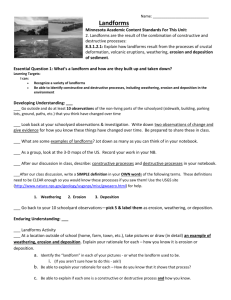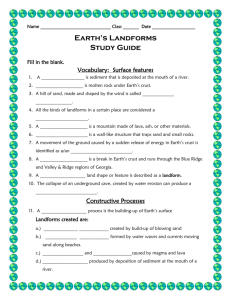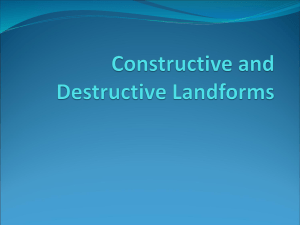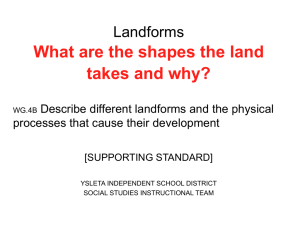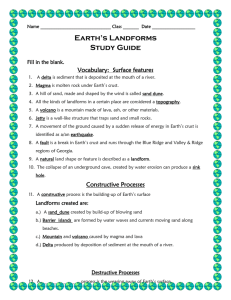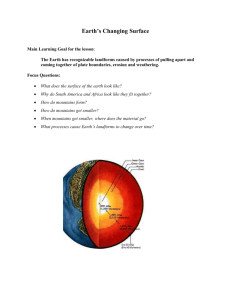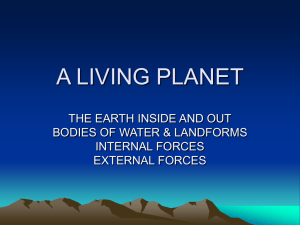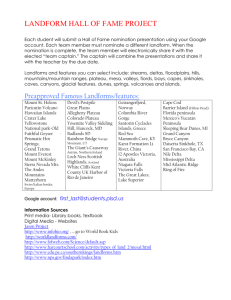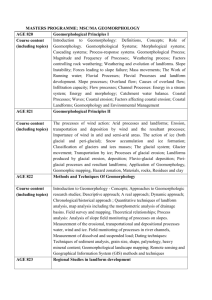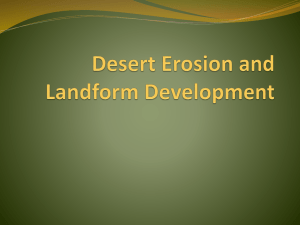Bellwork * Review of last week
advertisement
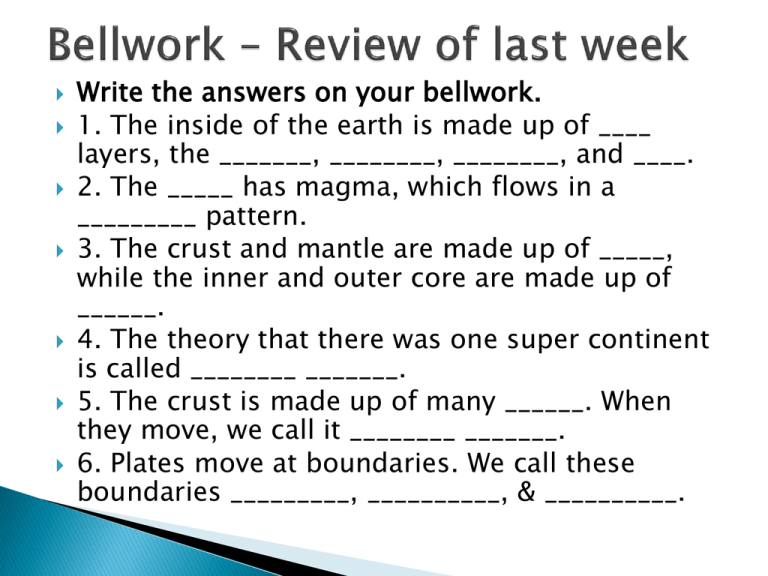
Write the answers on your bellwork. 1. The inside of the earth is made up of ____ layers, the _______, ________, ________, and ____. 2. The _____ has magma, which flows in a _________ pattern. 3. The crust and mantle are made up of _____, while the inner and outer core are made up of ______. 4. The theory that there was one super continent is called ________ _______. 5. The crust is made up of many ______. When they move, we call it ________ _______. 6. Plates move at boundaries. We call these boundaries _________, __________, & __________. 1. 2. 3. 4. Bellwork (review of layers of the Earth) Notes, Landform Creation Videos, Erosion HW: ◦ Honors – explain the difference between erosion and weatherine ◦ Standard – create a “cartoon strip” with one block for each of the four spheres of the outer Earth. Remember: Map Quiz on Wednesday, Quiz 2.1 next week Objective: To discern the difference between primary and secondary landforms Question: How are landforms created? 4 outer spheres to the Earth ◦ Lithosphere = Earth’s crust, landforms ◦ Hydrosphere = Earth’s water ◦ Biosphere = Earth’s living things (plants, animals, fungi, humans, etc) ◦ Atmosphere = Earth’s gasses, winds, weather Landform = a geographical feature of the Earth, created by a natural process How are landforms created? ◦ 1. Internal Process (Plate Tectonics): Example = mountains, volcanoes, islands, fault lines, rift valleys ◦ 2. External Process Erosion Weathering Sediment Deposit Erosion = the wearing away of a solid over time by natural causes ◦ Usually happens by wind, water, ice Weathering = decomposition of Earth’s materials because of direct contact with the atmosphere/chemicals How are Erosion and Weathering Different? ◦ Both wear away at landforms to mold them ◦ Erosion uses wind, water, or ice to move particles to a new location, where it deposits them ◦ Weathering is a process where the particles are gone forever, due to a chemical reaction or decomposition Sediment Deposit = when Earth’s particles are carried by wind, water, or ice from erosion elsewhere and left in a new place (deposited) Erosion Video Glacier Video Weathering Video 1. atmosphere 2. biosphere 3. hydrosphere 4. lithosphere 4 outer spheres of the Earth A. rock B. tree C. fungus D. lake E. groundwater F. oxygen G. sandy beach H. cloud I. wind J. grass Examples – match to sphere 1. Bellwork – Review outer spheres of the Earth (Check HW) 2. Landform Creation, Finish Notes 3. Standard: Videos Honors: Google Earth Tour 4. HW: Standard – Primary/Secondary matching MAP QUIZ TOMORROW, Quiz 2.1 Next Tuesday Primary Landforms = those created through tectonic activity Secondary Landforms = those created through erosion, weathering, or sediment deposit. Alluvial Fan : deposit formed at the bottom of a mountain, valley, or canyon from a fast flowing stream or river Valley = deep area between two mountains, carved out by glaciers or rivers Canyon: deep ravine between two cliffs carved out by a river Delta: landform at the mouth of the river, where it flows into the ocean, where there is a deposit of soil, sand, and rock (good for farming) Plateau/Mesa = flat topped mountain or hill, with sides carved by wind over time Continental Shelf – a part of the continental crust of a continental plate, is the edge of each continent Put these landforms into the chart off the board based on the type of landform they are: Continental shelf Fault Glacier Plateau Volcano Delta Mountain Rift Valley River Valley *If you don’t know what a landform is, Look it up!
